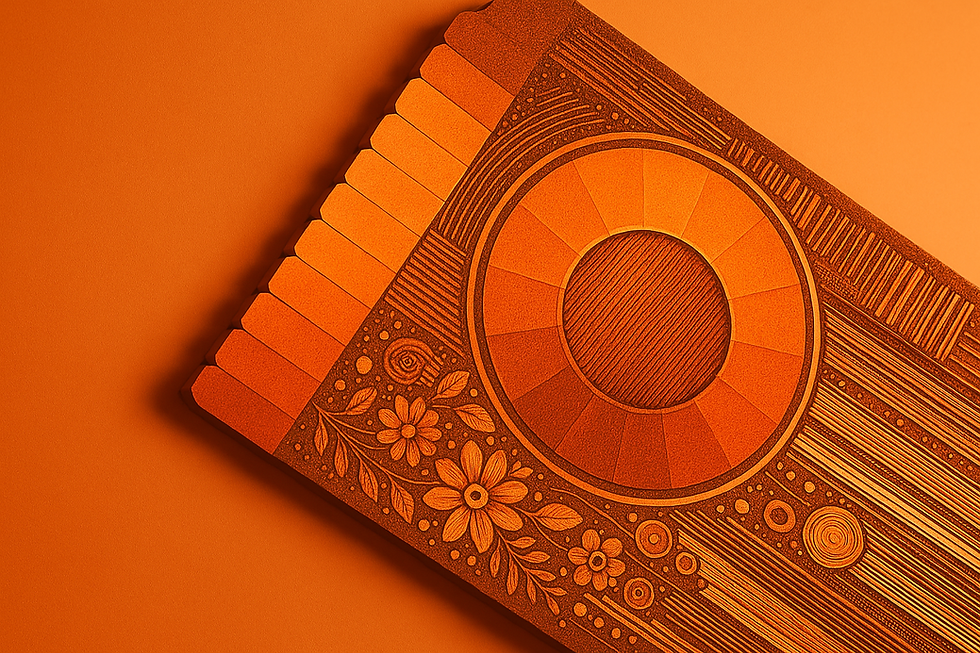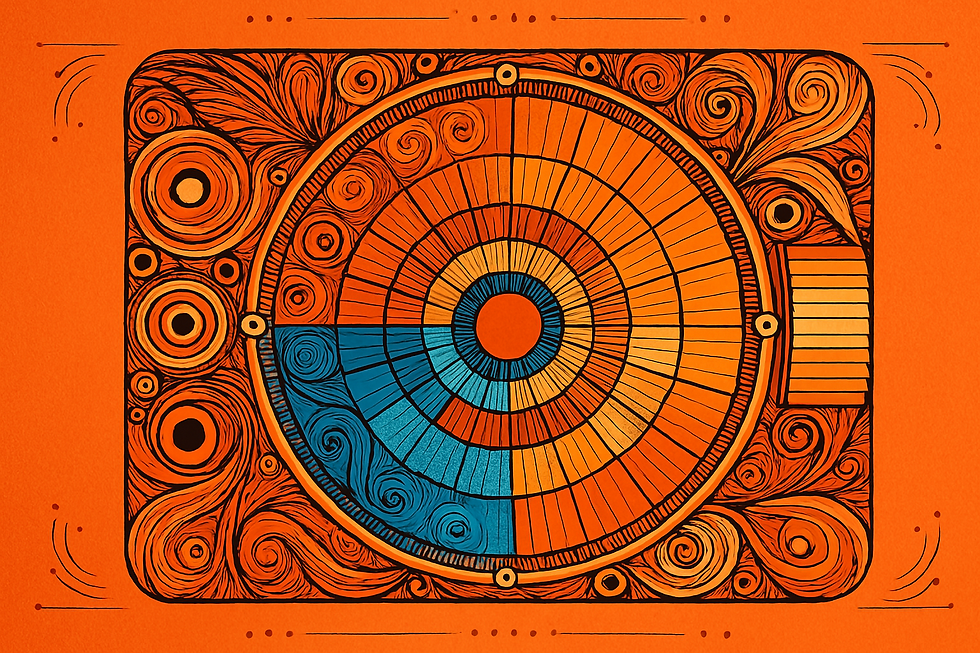Orange Color: Everything to Know About the Color Orange
- The Finest Writer

- Apr 12
- 6 min read
Updated: Apr 17

Welcome to our comprehensive guide on the vibrant and energetic color orange! In this article, we will take you on a journey through the dynamic and captivating world of orange, exploring its origins, meaning, symbolism, and diverse applications.
Known for its warm and lively nature, orange holds a universal appeal that has fascinated artists, designers, and enthusiasts alike.
Join us as we delve into the depths of orange, unraveling its secrets and uncovering its significance in various aspects of our lives. Whether you're seeking inspiration for your next creative project or simply curious about this bold hue, this article is your ultimate resource to unlock everything there is to know about the color orange.
What Color is Orange?

Orange is a secondary color that sits between red and yellow on the visible spectrum of light. It is often described as a warm, vibrant, energizing, and attention-grabbing hue. Orange is known for its lively and upbeat nature, usually associated with warmth, creativity, and enthusiasm. It is a color that naturally draws the eye and can evoke various feelings, from excitement and vitality to warmth and comfort.
How to Make Orange?

Orange is a secondary color, which is created by mixing two primary colors: red and yellow. It can also be represented in different color models such as RGB, CMYK, and HEX.
Here are the values and codes for orange in various formats:
Orange RGB Values
● Red: 255
● Green: 165
● Blue: 0
Orange HEX Color Code
The HEX code for orange is #FFA500.
Orange CMYK Code
● Cyan: 0%
Orange CMYK Code
● Magenta: 35%
● Yellow: 100%
● Black: 0%
Orange Web Safe Color
In the web-safe color palette, the color orange is represented by #FF9900.
Paint Mixing to Create Orange
To create orange with physical paint, you can mix equal parts of red and yellow. Adjusting the proportions will allow you to create different shades of orange, such as a lighter, peachy tone by adding more yellow, or a deeper, burnt orange by adding more red.
Orange Light and Perception
Orange results from how our eyes perceive light with wavelengths between those of red and yellow. It can vary in appearance depending on lighting conditions and surrounding colors.
Orange is a versatile and invigorating color used in various design, fashion, and artistic applications. Whether you're designing a website, painting a room, or creating artwork, these color values and codes will help you incorporate the vibrant essence of orange into your projects.
What Colors Match Orange?


Orange is a versatile color that can be paired with several complementary and harmonious colors to create visually appealing combinations. Here are some color schemes that work well with orange:
Orange and White
The combination of orange and white creates a fresh and clean look. White provides a bright backdrop that allows orange to stand out, adding a sense of balance and brightness to the overall palette.
Orange and Blue
Orange paired with blue creates a striking and dynamic color scheme. The cool tones of blue contrast with the warmth of orange, resulting in a balanced and lively palette.
Orange and Gray
The combination of orange and gray creates a modern and sophisticated color scheme. The
neutral tones of gray complement the vibrancy of orange, resulting in an elegant and balanced palette.
Orange and Brown
Orange and brown form a warm and earthy duo. The rich, natural tones of brown enhance the warmth of orange, creating a harmonious and inviting palette.
Orange and Green
The combination of orange and green evokes a sense of nature and freshness. The cool tones of green complement the warmth of orange, creating a harmonious and invigorating palette.
These are just a few examples of colors that work well with orange. Don't be afraid to experiment and explore different combinations to find the perfect match for your project or personal style.
What is Orange’s Complementary Color?

The complementary color of orange is blue. In the traditional color wheel, orange sits opposite blue, creating a strong visual contrast that is striking and harmonious. When orange and blue are placed together, they make a vibrant and dynamic combination that is lively and balanced.
What Colors are Similar to Orange?

Similar to orange colors can be found within the orange and red-yellow spectrum. Here are some colors that share similarities with orange:
Tangerine: Tangerine is a bright, reddish-orange color that closely resembles orange but with a slightly deeper and more vibrant tone. It carries the same lively and energetic qualities as orange.
Peach: Peach is a soft, pale shade of orange with a more pastel appearance. It shares the same warm and inviting qualities as orange but with a lighter and more delicate tone.
Burnt Orange: Burnt orange is a dark, earthy shade of orange with a brownish undertone. It retains the same warmth and richness as orange but with a more muted and subdued appearance.
Coral: Coral is a warm, pinkish-orange color that is similar to orange but with a more pinkish tone. It shares the same vibrant and joyful qualities as orange.
Amber: Amber is a deep, yellowish-orange color that is similar to orange but with a richer and more golden tone. It carries the same warmth and vibrancy as orange.
These colors are closely related to orange and can be used in combination or as alternatives to create a harmonious color palette.
What Does Orange Symbolize?

Orange symbolizes a variety of meanings and conveys different emotions depending on the
context. Here are some common symbolisms associated with orange:
Energy and Vitality: Orange is often associated with energy, vitality, and enthusiasm. Its bright and dynamic tones evoke feelings of excitement and positivity, often used to symbolize action and movement.
Creativity and Expression: Orange is also linked to creativity and self-expression. Its vibrant and stimulating appearance encourages originality and innovation, often associated with artistic endeavors and creative projects.
Warmth and Comfort: Orange is seen as a color of warmth and comfort. Its warm and inviting tones evoke feelings of coziness and relaxation, often used in home decor to create a welcoming atmosphere.
Optimism and Joy: Orange is often associated with optimism and joy. Its bright and cheerful appearance conveys a sense of happiness and positivity, often associated with sunny, uplifting emotions.
Sociability and Communication: Orange is also connected to sociability and communication. Its lively and engaging tones promote interaction and connection, often used in settings that encourage social interaction and collaboration.
Courage and Confidence: Orange is often associated with courage and confidence. Its bold and daring appearance evokes a sense of fearlessness and assertiveness, often used to symbolize determination and strength.
It's important to note that color symbolism can vary across cultures and personal interpretations. The meanings associated with orange can be influenced by personal experiences, cultural beliefs, and the specific context in which it is used.
The History of Orange

The history of orange as a color is rich and varied, with connections to art, culture, and
symbolism across the globe. Here are some key points in the history of orange:
The Origins of the Name: The word Orange is derived from the Old French word "orenge" which in turn comes from the Arabic word "nāranj" and the Persian word "nārang," referring to the fruit. The color orange has been associated with warmth, energy, and creativity since ancient times.
Orange in Ancient Civilizations: In ancient civilizations, orange was a prized color often associated with the sun, fire, and harvest. The orange dye, extracted from natural sources like saffron and ochre, was highly valuable and used in religious ceremonies, clothing, and art.
Orange in Art and Religion: Throughout history, orange has been used in religious art and symbolism. In Hinduism, orange (or saffron) is a sacred color representing purity, spirituality, and the pursuit of knowledge. In Christianity, orange is often associated with the flame of the Holy Spirit.
Orange in Fashion and Textiles: Orange has been a popular color in fashion and textiles for centuries. Its bright and attention-grabbing appearance made it a favorite for everything from royal robes to modern-day fashion. Orange clothing has often been associated with energy, creativity, and celebration.
Orange in Politics and Revolution: Orange has also played a significant role in political movements and revolutions. It has been the color of choice for movements advocating for freedom and justice, symbolizing determination and positive change.
Modern Usage: In the 20th and 21st centuries, orange has remained a popular and versatile color in fashion, interior design, and branding. Its bright appeal and ability to adapt to various styles and trends have made it a favorite among designers and consumers alike.
Today, orange continues to be a popular and versatile color used in various applications, from interior design and fashion to branding and digital media. Its lively and dynamic qualities have made it a favorite among artists, designers, and individuals seeking a color that exudes both energy and creativity.




